Due to increasing cyber threats, businesses continuously seek innovative solutions to safeguard their web apps. Web application penetration testing is one of these strategies, and it has already become an integral component of any effective security plan.
The popularity of penetration testing, also known as pentest or pentesting, is steadily increasing. According to Markets & Markets, the pentesting industry is expected to increase from $1.4 billion in 2022 to $ 2.7 billion in 2027 at 13.7% of CAGR. In this blog, we’ll explain what penetration testing for a web application is, why it is vital, and what defensive value it provides.
What is Web Application Penetration Testing?
Web application penetration testing is when cyber security experts replicate a real-world cyber attack on web apps, websites, or web services to uncover potential dangers. This is done to identify existing vulnerabilities that hackers might readily exploit.
Within an organization, web servers, whether local or cloud-based, are vulnerable to malicious attacks. Penetration testing involves cyber security experts conducting a series of simulated assaults that imitate genuine unauthorized cyber-attacks, determining the level of the vulnerability, and identifying flaws and the effectiveness of the organization’s overall application security posture.
Are you a business seeking web app penetration testing? Your search may have come to an end! Qualysec Technologies can be your partner in safeguarding your web apps. Talk to our expert security consultants for free today!
Talk to our Cybersecurity Expert to discuss your specific needs and how we can help your business.
Why Web Application Pen Testing are Performed?
Web application penetration testing is an important security measure for any firm that hosts or administers online applications. Web apps are a popular target for cyber thieves due to their widespread use, accessibility, and frequent lack of security protections. According to estimates, 98% of online apps are vulnerable to cyber assaults, which might include malware or redirection to dangerous websites, among other things. Furthermore, 72% of these vulnerabilities stemmed from defects in the program code itself. Here are the top reasons why web app pentests are performed:
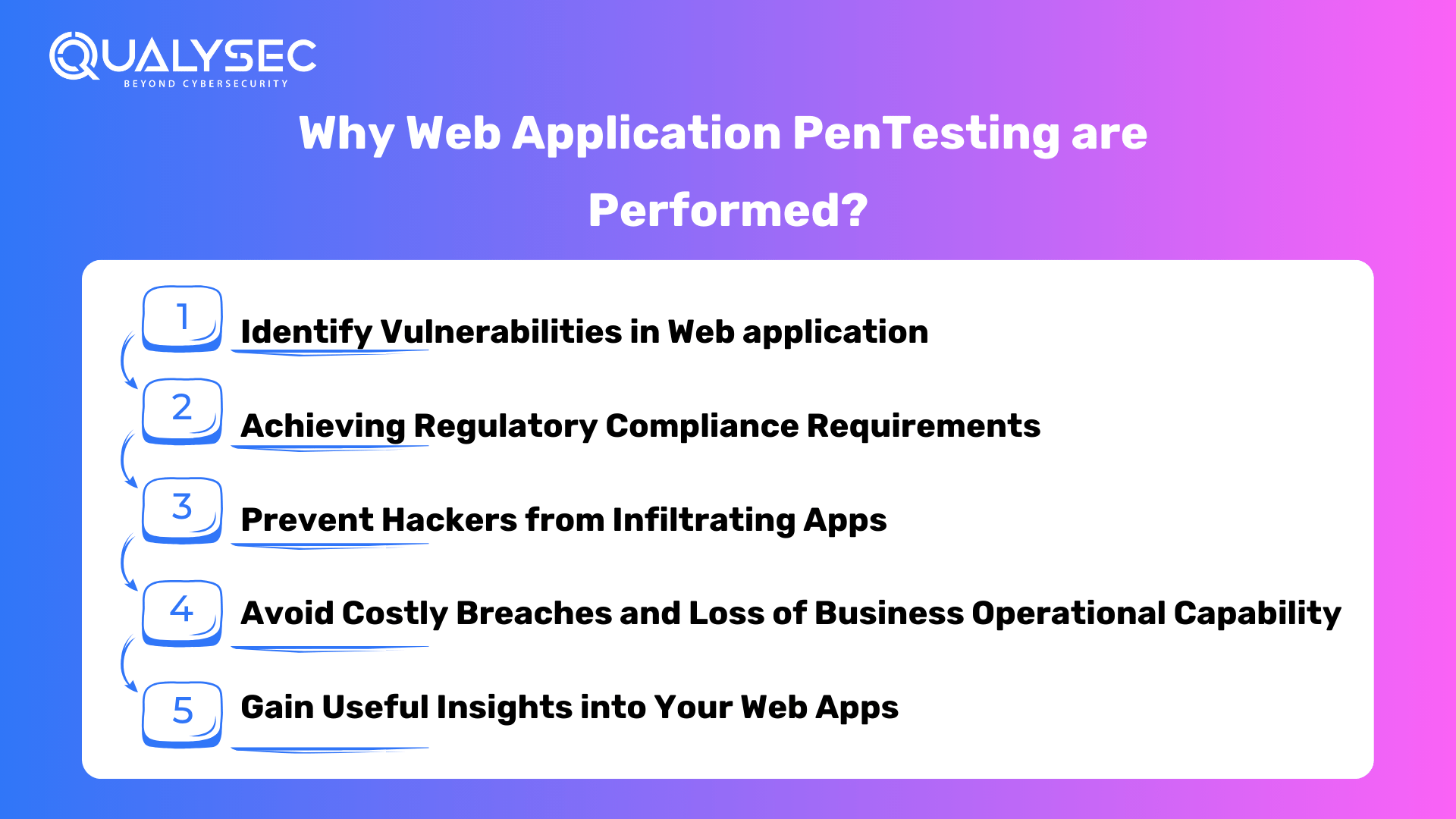
1. Identify Vulnerabilities in Web application
Penetration testing is critical in identifying security holes before they become a target for attackers. It’s like a treasure hunt, with the wealth being possible vulnerabilities and the hunters being ethical hackers trying to locate these jewels before the pirates do. In doing so, they defend the application’s integrity, user confidence, and data security.
2. Achieving Regulatory Compliance Requirements
Meeting compliance is not a simple administrative effort; it signifies developing a trustworthy digital character. The penetration testing process is equivalent to a seafaring vessel undergoing intense inspection before setting sail. This examination ensures that the ship can withstand the unpredictable waves of the digital realm while securely transporting its important cargo—user data.
3. Prevent Hackers from Infiltrating Apps
Penetration testing is similar to rehearsing for a real-life breach by a hacker. Regular penetration testing enables you to be proactive in your real-world approach to reviewing the security of your IT infrastructure. The approach exposes flaws in your security, allowing you to correct any deficiencies before an attack happens.
4. Avoid Costly Breaches and Loss of Business Operational Capability
Recovering from the consequences of a data breach is undoubtedly expensive. Legal fees, IT remediation, client protection programs, lost revenue, and dissatisfied customers may cost corporations millions. Regular penetration testing is a proactive method to remain on top of your security. It may assist reduce financial loss in the case of a breach while also preserving your brand and image.
5. Gain Useful Insights into Your Web Apps
Penetration testing reports can offer you vital information about your network’s vulnerabilities and how to enhance it. These tests are thorough and may be used by pentesters and IT experts for several applications. Penetration testing may help you prioritize your risks and create actionable strategies linked with your company’s beliefs, objectives, and resources, allowing you to focus on particular elements of your IT based on individualized findings.
8 Essential Steps and Methods for Conducting Web Application Penetration Testing
To draw attention to the distinction between an application and a web app, pentesting the web application focuses mostly on the environment and configuration of the web app. In other words, testing the web application focuses on getting public information about the web app before moving on to map out the network involved in hosting it.
Web application penetration testing often involves the use of a vulnerability scanner to probe and find security flaws such as misconfiguration, unpatched software, SQL injection, cross-site scripting, and so on. Then, manual pentesters penetrate your system;
- by checking the legitimacy of the vulnerabilities discovered by the scanner.
- by looking for more complex vulnerabilities, such as business logic problems and payment gateway issues.
Here’s an overview of the complete 8 steps procedure of web application Penetration Testing :
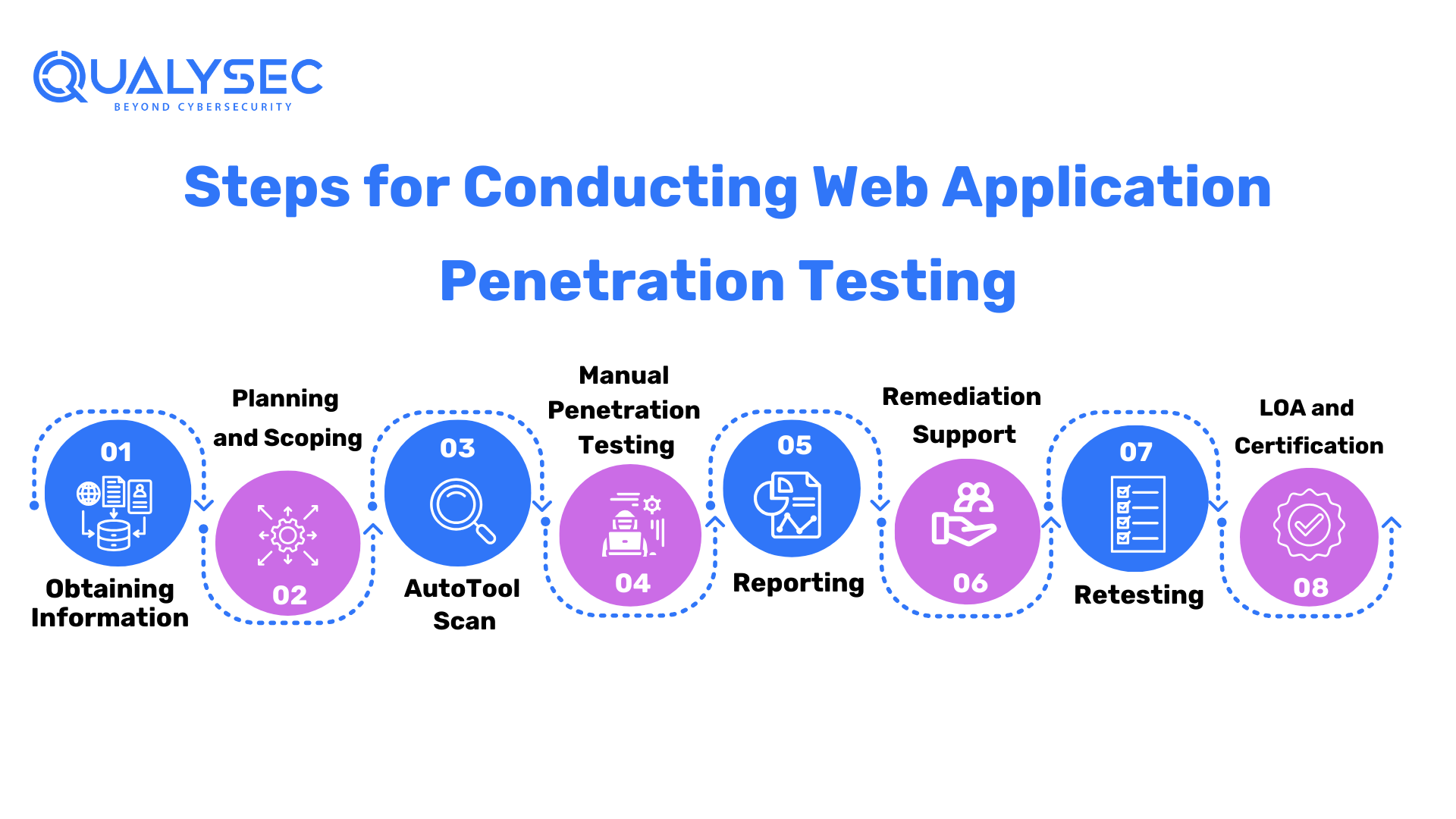
1. Obtaining Information:
The initial stage in web application penetration testing is to gather as much information as possible. This requires a two-pronged approach: using readily available information from your end and utilizing several approaches and tools to gain technical and functional insights. Understanding user roles, permissions, and data flows is critical for creating an effective testing strategy.
2. Planning and Scoping
The pentesters start by carefully establishing the objectives and goals. They probe deeply into the application’s technical and functional complexity. Furthermore, this thorough research enables testers to modify their testing method to target certain vulnerabilities and threats in the application.
A thorough web application penetration testing strategy is developed, describing the scope, methodology, and testing criteria. Furthermore, the business provides a high-level checklist to help guide the testing process. They gather and prepare the necessary files and testing equipment. This process comprises creating testing parameters and validating script availability to guarantee a smooth and effective assessment.
3. Auto Tool Scan
An automatic and invasive scan is required during the application testing process of web, particularly in a staging environment. This scan thoroughly examines the application’s surface level for vulnerabilities using particular pentesting tools. Furthermore, the automated tools simulate possible attackers by crawling through each request in the application, exposing potential flaws and security vulnerabilities.
By executing this invasive scan, testers proactively identify and correct surface-level vulnerabilities in the staging environment, acting as a deterrent to potential attacks. Furthermore, this technique allows a thorough web application penetration testing assessment and prompt correction, improving the application’s security posture before it is deployed in a production setting.
4. Manual Penetration Testing
The testers provide a broad range of deep manual penetration testing services tailored to your individual needs and security standards. Furthermore, this unique technology enables a full evaluation of possible vulnerabilities in online applications. This web application penetration testing strategy helps systematically assess online applications, looking for vulnerabilities in authentication, data management, and other crucial areas to help improve the application’s security posture.
5. Reporting
The testing team discovers and categorizes vulnerabilities discovered throughout the investigation, ensuring that any potential dangers are detected. A senior consultant does a high-level penetration test and extensively analyzes the results.
This ensures the highest level of quality in web application penetration testing techniques and reporting accuracy. This extensive documentation is valuable for knowing the application’s security status. This detailed reporting method ensures that clients and developers receive relevant information about the application’s security state and practical advice for maintaining a strong security posture.
Do you want to discover how a full report might improve the security of your web application? You may download a copy of our sample report here!
Latest Penetration Testing Report

6. Remediation Support
If the development team needs help reproducing or mitigating detected vulnerabilities, the service provider offers valuable support through consultation calls. Furthermore, penetration testers who thoroughly grasp the discovered vulnerabilities urge direct engagement to help the development team analyze and respond to security problems. This collaborative approach ensures that the development team receives competent assistance, allowing for the seamless and speedy resolution of vulnerabilities while improving the application’s security posture.
7. Retesting
After the development team has completed vulnerability mitigation, a vital step of web application penetration testing happens. The pentesters do a thorough examination to guarantee that the therapies work. The final report is extensive and includes the following sections:
- History of Discoveries
- State of Assessment
- Screenshots
8. LOA and Certificate
The penetration testing firm provides a key document known as a Letter of Attestation. Furthermore, this letter supports the conclusions of the web application penetration testing and security assessments and serves various functions:
- Confirming security level
- Providing stakeholders with security information
- Compliance Completion
In addition, the testing company will provide you with a Security Certificate, which will enhance your ability to represent a secure environment, promote confidence, and meet the needs of various stakeholders in today’s growing cybersecurity landscape.
What Tools Are Used for Web Application Penetration Testing?
With the exponential growth in cyber threats, enterprises must secure the security and integrity of their web applications. Extensive testing and inspection are required to establish robust security. These technologies help security experts uncover vulnerabilities, discover gaps, and defend online applications against possible assaults.
The entire web app penetration testing procedure relies on the reconnaissance phase and found vulnerabilities. Comprehensive research makes finding the correct vulnerability and obtaining access to the app much easier. Tools like web scanners and search engines can assist you in passively gathering information on your target. Here we’ve listed the top 9 tools that help in securing web apps:
1. Burp Suite
Burp Suite is an integrated platform and graphical tool for doing web application penetration testing. It supports the whole testing process, from initial mapping and analysis of an application’s attack surface to detecting and exploiting security flaws.
Burp Suite’s many features make it a comprehensive web application security testing tool that can be utilized throughout the penetration testing process. Gathering HTTP traffic with Burp Suite is simple, and the opportunities for exploitation are endless.
2. Netsparker
Netsparker is a popular web vulnerability management software solution used by IT, security operations, and development teams worldwide. It is a completely customizable Enterprise Dynamic Application Security Testing (DAST) solution.
Netsparker scans all of your organization’s web pages, allowing you to obtain a better understanding of your applications and any vulnerabilities. Any webpage or web application can be inspected. They can be based on any technological stack, language, or framework.
3. Wireshark
Wireshark has several applications, including debugging networks with performance difficulties. Cybersecurity experts often use Wireshark to trace connections, inspect the contents of suspicious network transactions, and detect network traffic surges.
The primary advantage of utilizing Wireshark for web application penetration testing is that it can help you debug and improve your network and its applications. Wireshark, for example, may help you discover and diagnose network issues such as sluggish connections, packet loss, congestion, misconfigurations, errors, and anomalies.
4. Metasploit
The Metasploit Framework is a Ruby-based modular web application penetration testing platform that allows you to create, test, and attack code. The Metasploit Framework is a collection of tools that may be used to assess security vulnerabilities, enumerate networks, conduct attacks, and avoid detection.
One of Metasploit’s primary use cases is its ability to uncover system flaws and attempt to attack them, giving businesses a clear awareness of potential vulnerabilities. It has become an industry-recognized tool trusted by several suppliers, making it an excellent alternative for internal security checks.
5. W3af
W3af is an open-source web application security scanner. The project includes a vulnerability scanner and attack tool for web applications. It also gives information about security flaws for use in penetration testing engagements.
W3af contains other characteristics related to exploitation, but they are too numerous to include in this article. Nonetheless, it is a quick and straightforward technique to collect information on the target system.
6. OWASP Zap
OWASP Zed Attack Proxy (ZAP) is a free security tool worldwide volunteers actively support. It automatically detects web application security flaws during development and testing. Experienced penetration testers may use OWASP ZAP for manual web application penetration testing.
ZAP has a wide range of scanning and testing options, including manual testing, automated scanning, and API testing, making it a comprehensive tool for identifying vulnerabilities in online applications. ZAP’s extensive collection of capabilities helps developers and security testers identify and mitigate common vulnerabilities, allowing them to improve the security posture of their applications.
7. SQLMap
SQLMAP is an open-source web application penetration testing tool. It automates detecting and exploiting SQL injection weaknesses, followed by gaining control of database servers. In addition, SQLMAP provides a detection engine with extensive functionality for penetration testing.
It simplifies the process of carrying out SQL injection attacks and grants access to hacked database servers. One of the key functions is database fingerprinting, which scans for vulnerabilities and potential exploits.
8. Nikto
Nikto is an open-source web server scanner that scans web servers for vulnerabilities in various areas, including malicious files and applications. Nitko looks for obsolete versions of web server apps. It conducts general and server-specific inspections. It also saves and prints any cookies received. Here are some additional features:
- It detects SQL injection, XSS, and other common vulnerabilities.
- It recognizes installed applications using headers, favicons, and files.
- It may also infer the subdomains of the scanned domain.
- It generates reports in plain text, XML, HTML, and CSV formats.
9. Open SSL
OpenSSL is an open-source command-line utility for generating private keys, creating CSRs, installing SSL/TLS certificates, and identifying certificate information. It is created to provide a reference guide to assist you in learning the most popular OpenSSL commands and how to apply them.
OpenSSL is a cryptographic library that allows for open-source implementations of the Transport Layer Security (TLS) and Secure Sockets Layer (SSL) protocols. It generates private keys, manages certificates, and enables client programs to encrypt and decode.
How Will Qualysec help you secure your application?
Do not enable hackers to infiltrate your web applications. Qualysec Technology’s professionals have over 3 years of expertise in offering excellent application security solutions to businesses from start-ups to Fortune 500 across diverse industries.
Qualysec Technologies makes every attempt to maintain the web application perfect by implementing strong methods of inspection through penetration testing. We offer a hybrid approach to testing that combines both automated and manual effort. With our extensive web application penetration testing, we prepare a comprehensive pentest report that gives deep insights into the vulnerabilities found.
We don’t just say that our report is developer-friendly; we make it so. With our comprehensive report, a developer can find and mitigate the vulnerabilities easily as we provide references. We also help the developers with consultation calls if they need help mitigating issues.
With our pentest report, any business can achieve regulatory compliance, such as PCI DSS, GDPR, SOC 2, HIPAA, and ISO 27001. Our certified pentesters can help you defend your web applications from unethical hackers. So, Why WAIT? Secure your Web Apps Today! Contact us right away!
Conclusion
Web application penetration testing is an important step in the Software Development Lifecycle (SDLC), assisting in developing a secure and flaw-free web application. It protects end users from cyberattacks such as data theft and exposing sensitive information.
It is usually advisable to do a thorough vulnerability assessment and penetration testing (VAPT) on your web application before or after putting it into production to uncover direct risks to your website/web application and, ultimately, your business. Furthermore, doing VAPT scans on your web application regularly is a best practice for protecting it against developing cyber threats and potential zero-day vulnerabilities and assaults. Partner with the best penetration testing service provider- Qualysec Technologies, today!
FAQs
What is the Methodology of Web App Pentesting?
Web application penetration testing entails a systematic sequence of actions to acquire information about the target system, identify vulnerabilities or faults, and research exploits that will attack such flaws or vulnerabilities to breach the online application.
How do I Manually Test a Web application?
Manually testing a web application involves the following steps:
- Understand the application’s functions and needs.
- Create test cases covering a variety of circumstances.
- Run tests by interacting with the application’s UI.
- Check predicted outcomes versus actual results.
- Document any flaws discovered.
- Iteratively test different aspects.
- Provide suggestions for improvements.
What is Web App Vulnerability Scanning?
Vulnerability scanners are automated technologies using web applications to detect security flaws. They evaluate web applications for typical security issues, including cross-site (XSS), SQL injections, and cross-site request forgery (CSFR).
Which of these are Common Web App Security Vulnerabilities?
The most common web app security vulnerabilities are:
- Injection Flaws
- Broken Authentication
- Cross-Site Scripting
- Insecure Direct Object References
- Security Misconfiguration
- Sensitive Data Exposure
- Missing Function Level Access Control
- Cross-Site Request Forgery















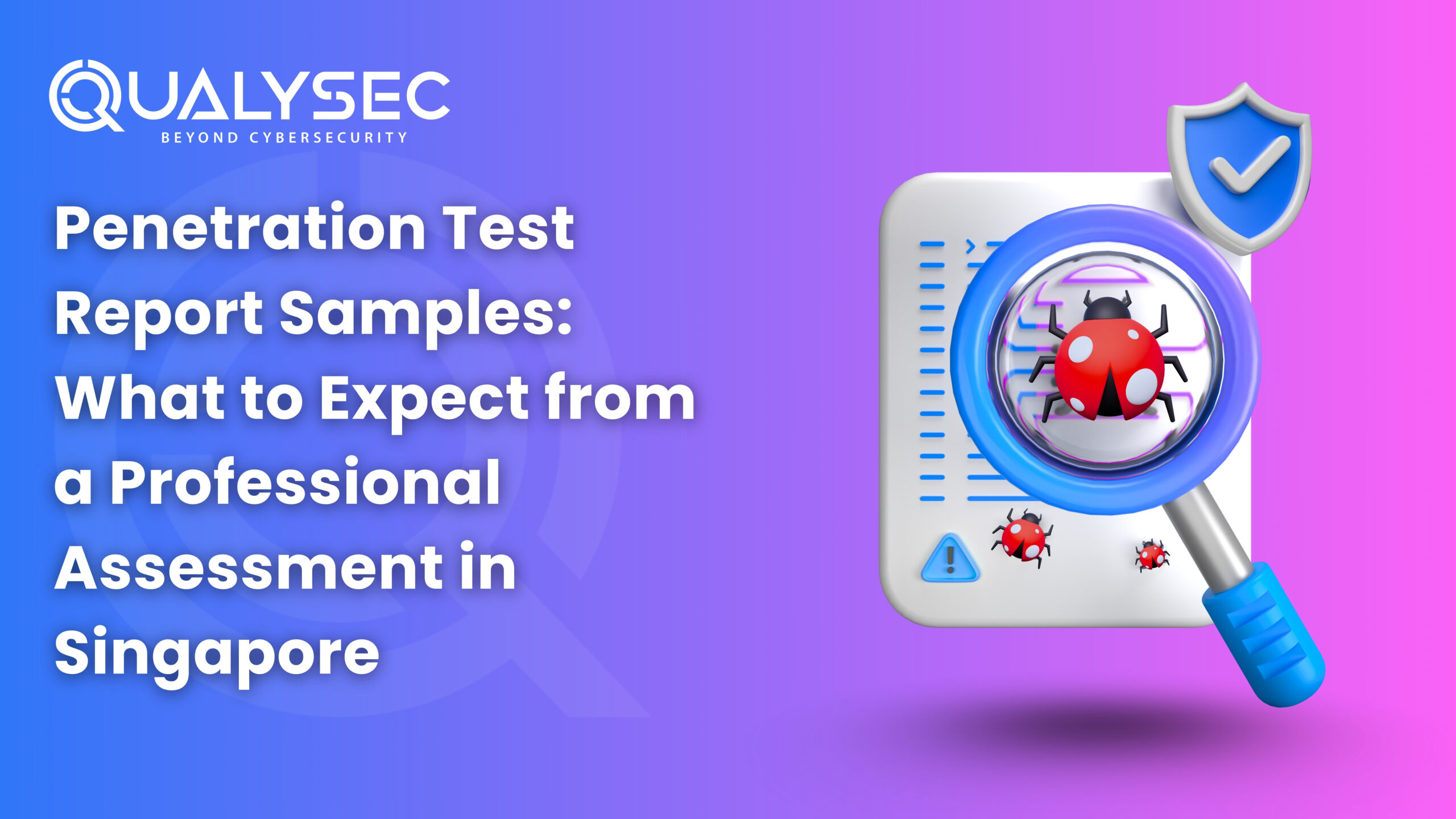
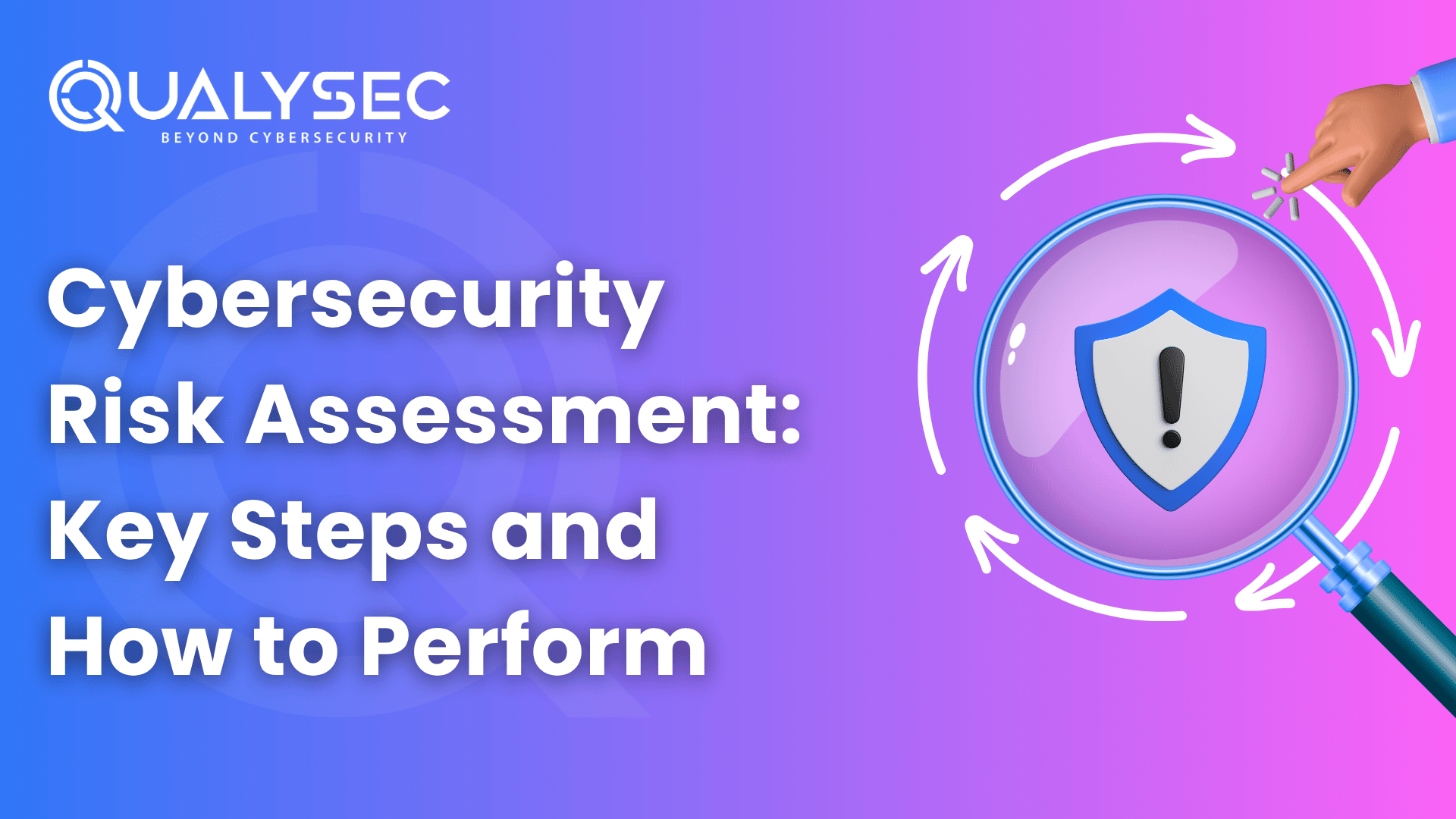
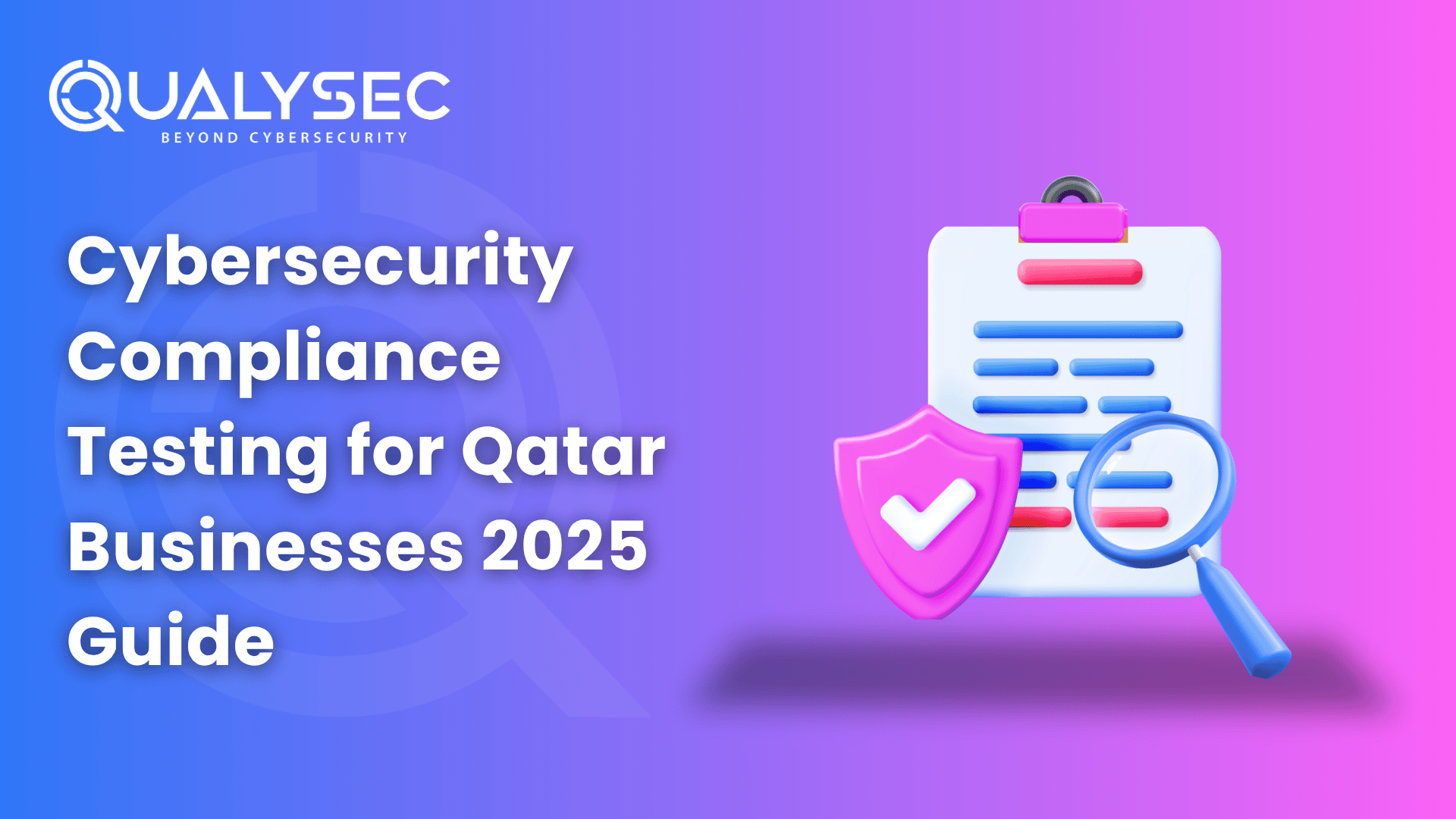
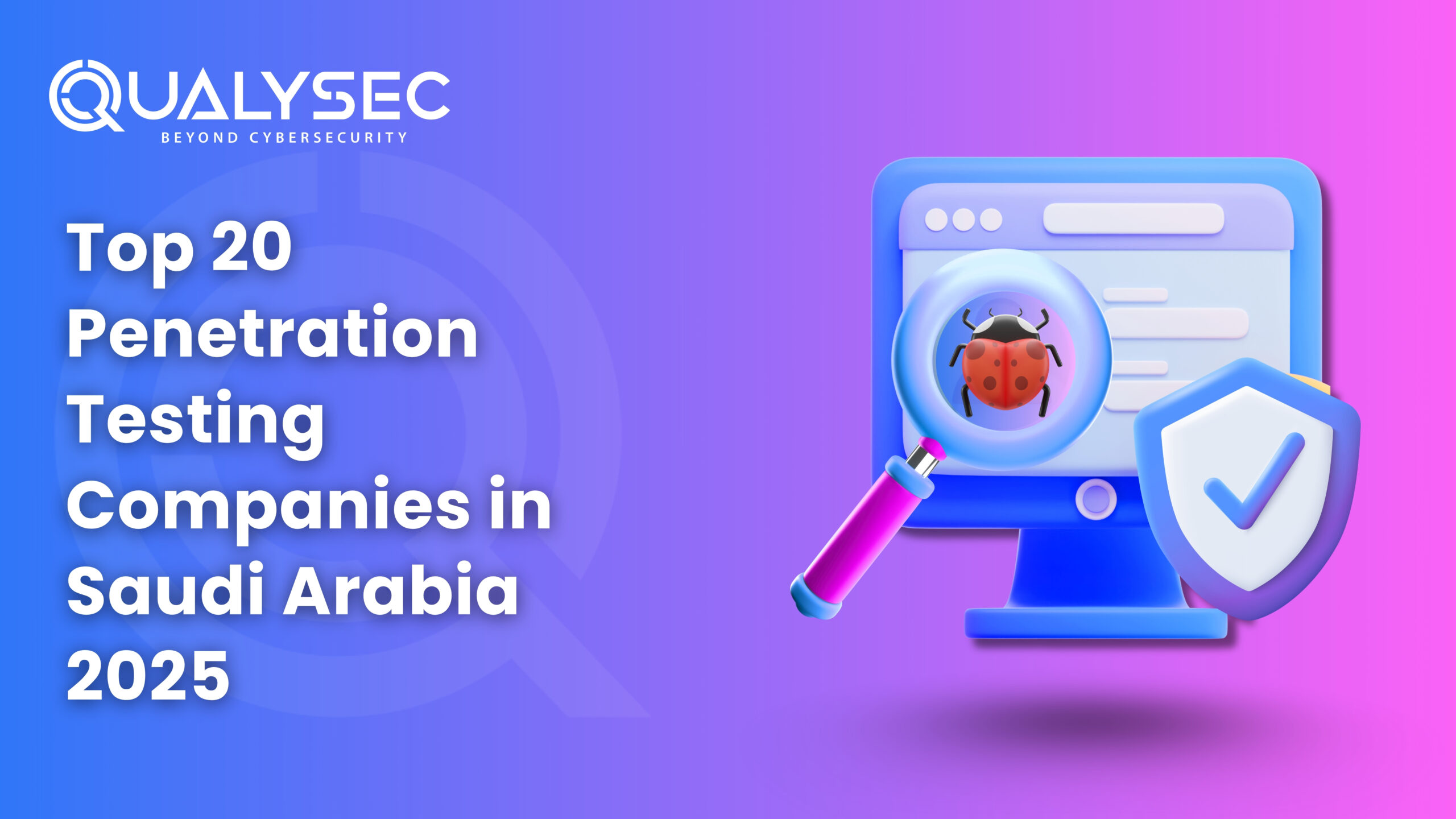































































































































































































































































































































0 Comments